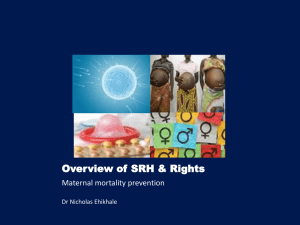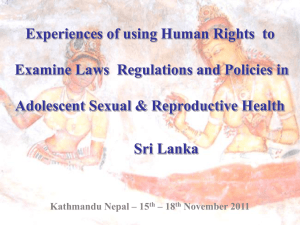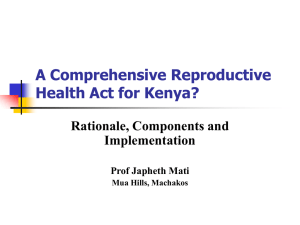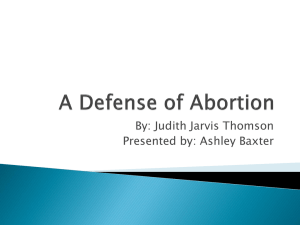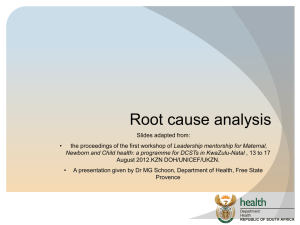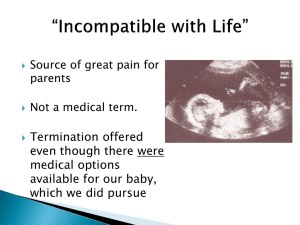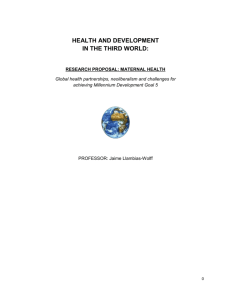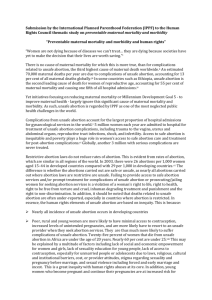Status of Maternal Health and Unsafe Abortion in Kenya
advertisement
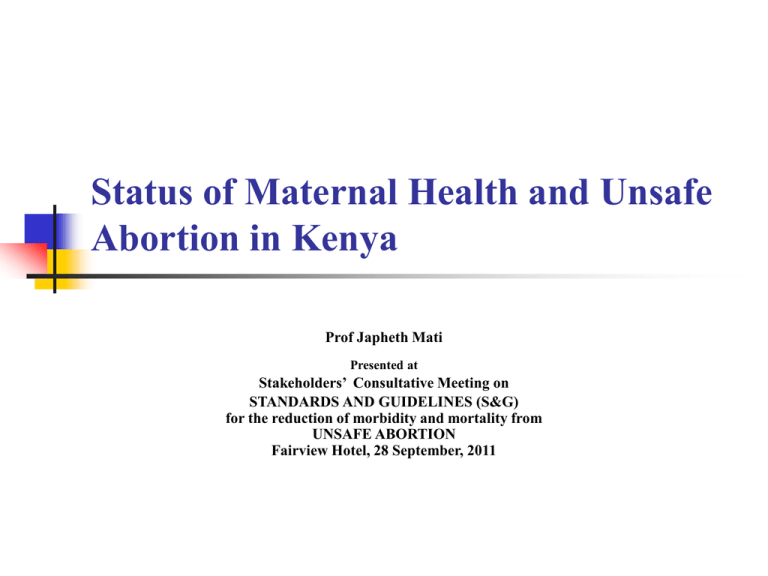
Status of Maternal Health and Unsafe Abortion in Kenya Prof Japheth Mati Presented at Stakeholders’ Consultative Meeting on STANDARDS AND GUIDELINES (S&G) for the reduction of morbidity and mortality from UNSAFE ABORTION Fairview Hotel, 28 September, 2011 September a rich month for maternal health news! Dadaab- a Daily Prayer for Complication-Free Births Dr. Beldina Gikundi's daily prayer is that the handful of malnourished pregnant Somali women who go into labour that day at the Dadaab refugee complex do not have complications, which might require a caesarean section. IPS News 19 September 2011 http://allafrica.com/stories/201109200021.html Mbale (Uganda) Doctors Held Over Death of Woman in Labour Police have arrested and detained six medical officers of Mbale Referral Hospital as it commenced an investigation into the death of a pregnant teacher and her baby two weeks ago. Cecilia Nambozo, the deceased, a teacher at Busamaga Primary School in Mbale Municipality, bled to death allegedly unattended to after failing to raise Shs300,000 the medical officers had reportedly asked for. The Monitor, 21 September 2011, http://allafrica.com/stories/201109210443.html Elusive Joy for Mothers and Babies as Cartels Run Maternity The Report of the Task Force on Pumwani Maternity Hospital has been handed over to government authorities for action. ‘Corruption, financial crisis, lack of critical supplies for mothers and babies, mistreatment of mothers, moral and ethical decadence, and absenteeism among doctors, are highlighted as some of the factors that have compromised the quality of services at the hospital’. Daily Nation on the Web 24 September 2011, http://allafrica.com/stories/201109250047.html Musyimi Calls for Caution On Abortion The Gachoka MP the Rev Mutava Musyimi has called for dialogue and inclusion of all stakeholders in the on-going debate by the Kenya Medical Practitioners regarding safe abortions. Nairobi Star (Nairobi) 20 September 2011 allafrica.com/stories/201109210120.html Indicators of Maternal Health in Kenya Progress towards achieving MDG 5in Kenya Target Indicators 2003-2008/9 MDG Target KDHS 2003 KDHS 2008-9 5.1 Maternal Mortality ratio (deaths per 100,000 live births) 414 488 5.2 Proportion of births attended by skilled health personnel (%) 42 44 5.3 Contraceptive prevalence rate (%) 39 46 5.4 Adolescent birth rate (%) 23 18 5.5 Antenatal care coverage 54 (percent made four visits) 47 5.6 Unmet need for family planning (%) 25.7 (approx 2.4 million women) 24.5 Fertility preferences among currently married women (KDHS 2008-09) 6% 14% 53% 27% W a nts no more child/ha d TL W a nts w a it 2+ yr W a nts child <2 yr Unde cide d or infe cund Chronic Maternal Morbidity Chronic maternal morbidity has received less attention compared with maternal mortality Long-term physical, psychological, social and economic consequences Chronic ill-health: anaemia, infertility, traumatic pelvic injuries, obstetric paralysis, chronic PID, depression and impaired productivity. Obstetric fistula (VVF and/or RVF) True incidence and prevalence of OF unknown AMREF estimates OF incidence at 3000 new cases annually with only 7.5% currently receiving treatment. Other factors that impact on maternal health Sexually transmitted infections have serious impacts on SRH which include maternal and perinatal morbidity and mortality. HIV/AIDS is a leading contributor to maternal mortality. Gender-based violence impacts profoundly on women's RH- STIs including HIV, unwanted pregnancies and unsafe abortion and their complications. One woman in four has been abused during pregnancy (UNFPA). Forced first sexual intercourse reported by 12 percent of women (KDHS 2008-09); and 55% of violated women admitted to the Nairobi Women’s Hospital are girls aged 0-15 years. SGBV against women and girls is a persistent occurrence in virtually all violent conflicts. Harmful practices: early marriage and FGM have serious impacts on maternal health- maternal and perinatal mortality and morbidity resulting from labour complications. Obstetric fistula commonly associated with FGM Unsafe Abortion Unsafe abortion- a public health concern In order to achieve MDG 5 on Improving Maternal Health, it is imperative that the issue of unsafe abortions is addressed. Unsafe abortion is an important contributor to the high maternal mortality rates in Kenya Granted unsafe abortion is simply one of several contributors to MMR, BUT it is one we know how to prevent- an important public health principle Incidence of unsafe abortion generally reflects the magnitude of unwanted pregnancies in any particular community. Unsafe abortion can be effectively minimized by ensuring women have easy access to contraceptive services, backed up by a positive legal framework that facilitates safe abortion. A significant proportion of pregnancies are unintended or mistimed. Total pregnancies (2003) Mistimed 30% Intended 44% Unintended 26% Source: SPECTRUM 2.38 Projections The dilemma of failed contraception Nearly a half of Kenyan women (46%) have chosen to practice contraception For anyone who chooses to practice contraception the hope is that it won’t fail. The realisation that this is not so, though infrequent, is what sends the hapless woman seeking termination of pregnancy. Failure to access SAFE Abortion leaves her the option of UNSAFE Abortion Ensuring equity in access to safe abortion services should be a key public health strategy- reaching the marginalised communities, who are the main victims of Unsafe abortion. The three-tier scheme for the prevention of abortion related morbidity and mortality Level of prevention and objectives Interventions Primary Prevention Prevent unwanted pregnancy a) Contraceptive information and counselling; b) Contraceptive services Secondary Prevention Prevent unsafe abortion a) b) Tertiary Prevention Post-abortion care = manage complications; prevent future unsafe abortion Counselling in early pregnancy, respect informed choice; Ensure access to safe abortion a) Clinical management of complications of unsafe abortion or incomplete abortion; b) Contraceptive counselling and services Thank you
